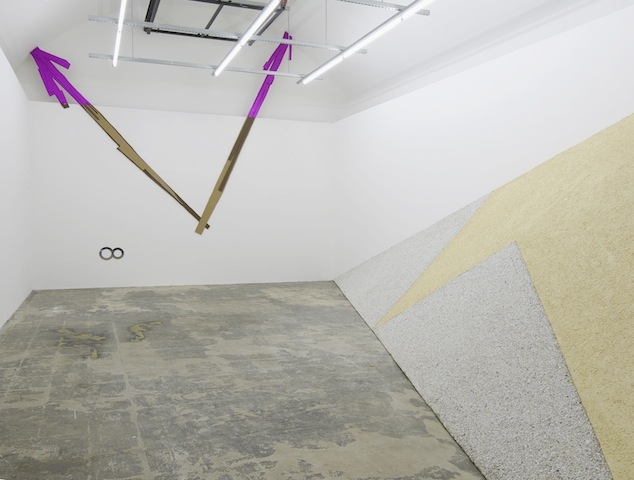Hollybush Gardens, London 24 March – 13 May
It was only at some point during the twentieth century that a life of leisure for everyone became an aim in itself. Machines would take over all the necessary labour, leaving humans to a work-free existence. Then the problem became: what would we do with all that time? Cyberneticians like Norbert Wiener thought we would spend our time in endless play and enriching our spiritual lives, an idealism that seems almost cute at this point. Knut Henrik Henriksen, in his show of sculptural interventions, suggests the more likely scenario: that we will just keep working, either keep making stuff or walk eagerly in circles, and still be just as stressed out and ruled by the clock. A giant set of arrows dominates the far wall at the back of the main gallery, their appearance as oversize clock hands assisted by the title Tick Tock (all works but one, 2017). The dull brown lengths of each shape turn suddenly to glittering bright pink arrow tips that abut the ceiling, as if testily reminding us that we should enjoy being dominated by time. It seems to read around 11:05.
The rest of the show is filled with a range of laborious constructions, from Gert, the tall, imposing column of pale wood that half-blocks the entrance to the gallery, to the alternating black and white boards of Day and Night that line the hallway floor and encircle a small portion of the gallery’s front hallway wall. Walking into the back gallery, Le Palais Idéal reveals itself, a large pebbledash triangle that bisects the entire floor, slanting up to a corner midway on the wall. An angular portion of the impressive lumpy surface is painted a pale yellow, giving it the air of an excerpt from a corner of a housing estate: something that appears semidecorative, but is actually there to deter skateboarders and rough sleepers.
This might not seem quite like an ‘ideal palace’, but its name actually comes from the intricate early-twentieth-century folly built from found stones by the French postman Ferdinand Cheval over a period of 30 years. Though named after Cheval’s intricate (spare-time) life’s work, and perhaps aspiring to such dedication, Henriksen’s own constructions have none of the rough, improvised solutions of Cheval’s naive art; his work more often has the sense of a maths buff on an acid trip, obsessively finding golden means and concentric circles in every nook and cranny. The painted design on his Palais Idéal no doubt finds its origin in the intricate intersections of the room’s proportions; though he also seems aware that such abstract conjectures eventually hit reality: Tool (to John) is a silver wheelbarrow that has been smashed flat, leaning against a wall as if having tried, and failed, to run through it.
Giving up on work, on usefulness, seems to be a central concern for Henriksen; his architecture is informal, decorative, but with an overdetermined sense of play, as if still hung up on the functionality that his constructions have left behind. Monument to the Unknown Worker feels like the actual centre of the show, a series of thick, gold marker lines on the floor, tracing the semicircular grooves left from whatever light industry inhabited the building before the gallery. It feels like an attempt at commun- ion with purposefulness, with having a defined sense of use and meaning, looking back fondly, but also with a sort of envy. The story of a man who lost interest in his job and started walking in circles is a mausoleum for the lost job, and a melancholic ode to a life of play to which we have been reluctantly liberated.
From the May 2017 issue of ArtReview
